Summary
CM2005 Quantitative Methods of Media and Communication Summary (9.4 scorer)
- Course
- Institution
A summary written by a 9.4 scorer. A comprehensive summary including lecture notes, SPSS notes, practical MCQ from lectures, and my own notes Regarding my own notes , they are mostly some reminders that I put to remind myself on some tricky/confusing parts. I only studied with this summary for my ...
[Show more]



